
Wm E Jones lead the 360th BS as the "low" squadron on this mission, flying AC# 44-8552, PU-X. The crew on his aircraft was:

Wm E Jones lead the 360th BS as the "low" squadron on this mission,
flying AC#
44-8552,
PU-X. The crew on his aircraft was:
P Jones, William E Capt
CP Hardy, James H F/O
N Stewart, James L
2lt
B Zwayer, James P
Capt
MN Wilson, Joseph R F/O
E Bostick, George
F T/sgt
R Lillis,
Joseph
T/sgt
TG Darland, William G Jr
1lt
G Engleman,
George
t/sgt
The complete aircraft loading list for the mission is shown below:
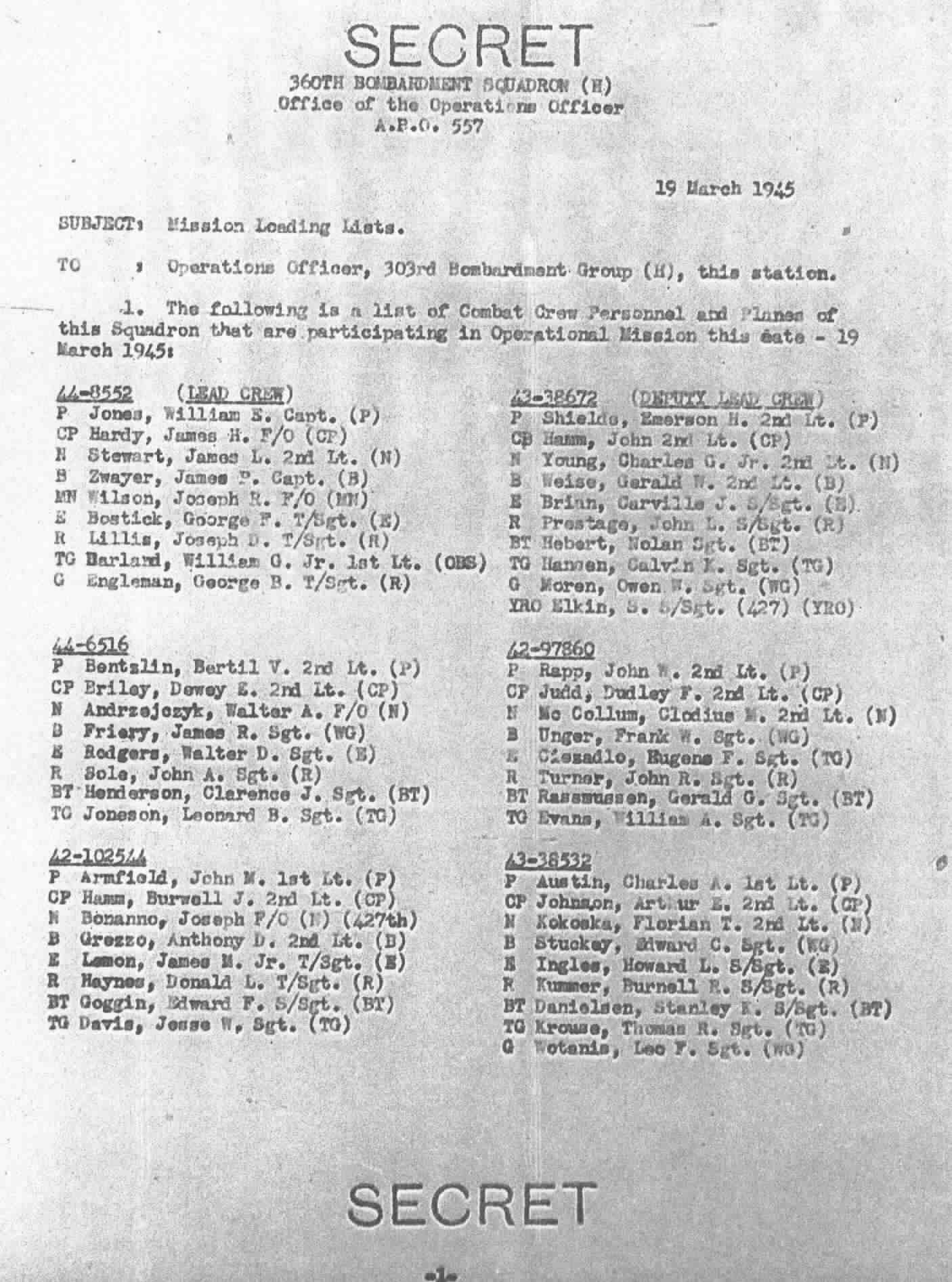
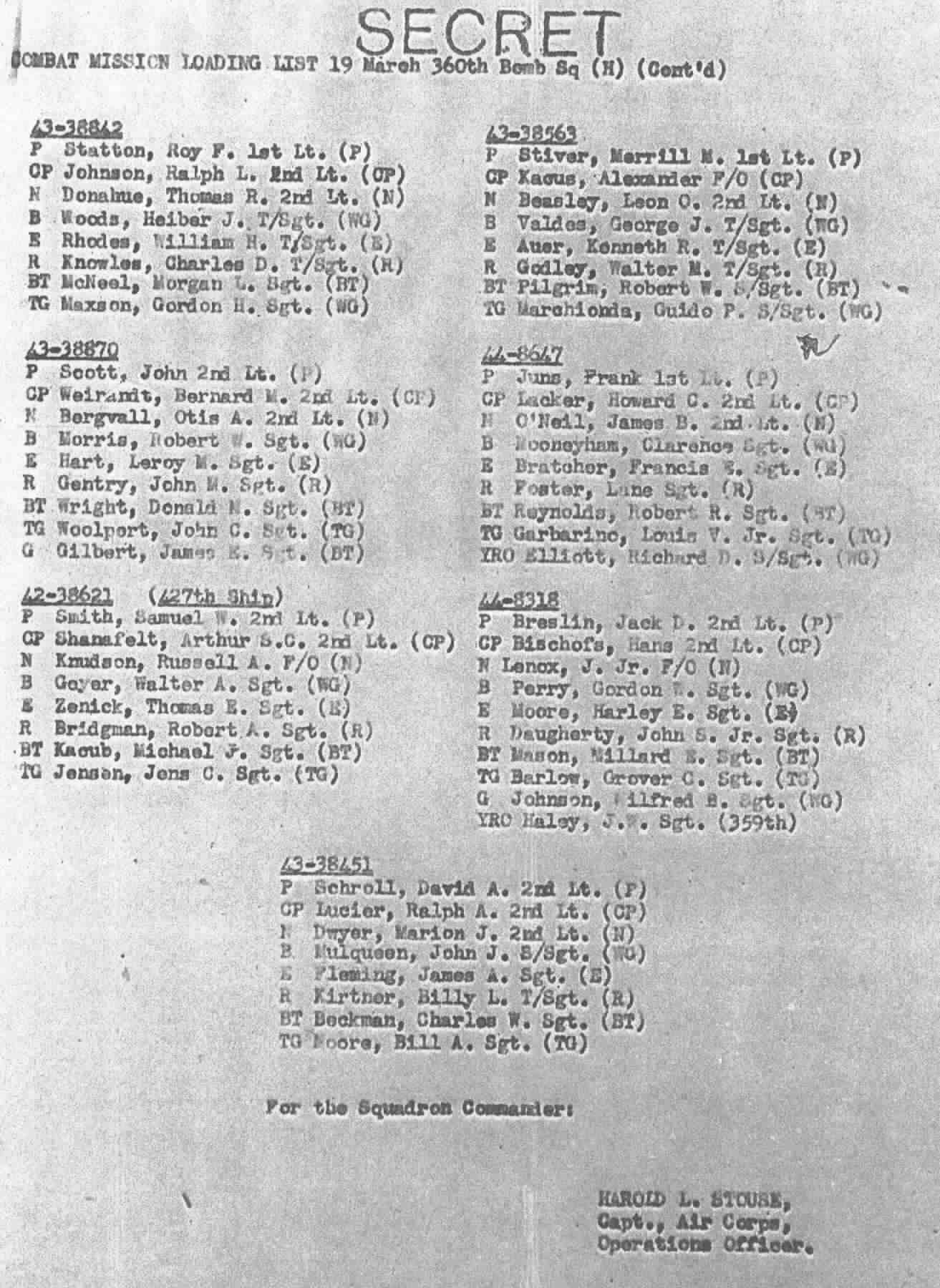
I have a mission briefing sheet for this mission, showing the planes in the low squadron.
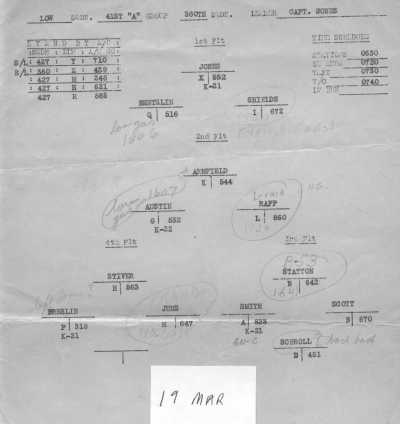 Click image for full sized image
Click image for full sized image
Mission report for 360th Bomb Squadron submitted by Capt William E
Jones
Jr.. ( courtesy of Jim Walling)
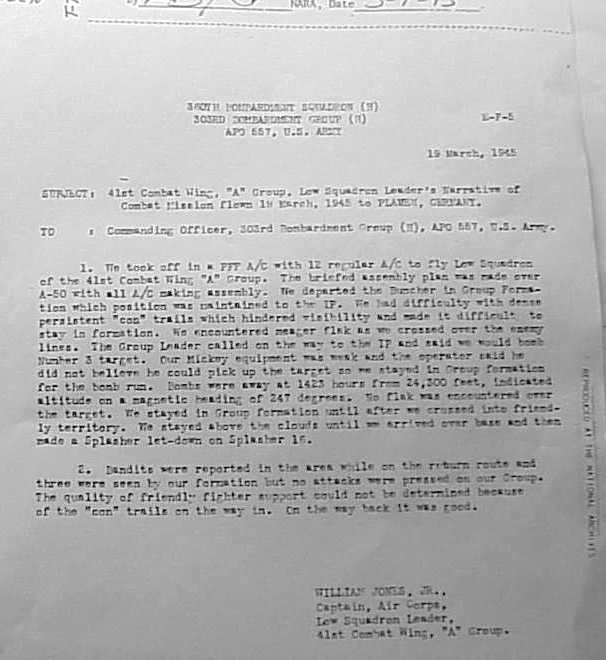
Another narrative of the mission was obtained from an internet
post
from Paul Watson, son of
Captain Ewing Watson, who was the Division
Commander (pilot of the lead plane of the lead bomb group) for the
mission.
The post was the transcribed memories that his father had of the
mission.
********************************************************
***********************************************************************Date: Wed, 2 Feb 2000
From: Paul M Watson <pwatson@utdallas.edu>
Subject: Mission PlauenAs transcribed by Paul Watson, all typos are mine...
Ewing Stuart Watson
LtCo. USArmyAF 533rd CO
Richardson, Texas
ph 972-238-9391Plauen Mission
March 19th, 1945After dinner on the evening before the March 19th, 1945 mission to Plauen
Germany was flown, my squadron Bombardier, Monk Lungren, came by my
quarters and said, "there is a pretty good film at our base theater
tonight, how about going with me to see it?" I said ok, and we went.A few minutes after the main feature began, Colonel Hall came in, sat down
beside me, and said, "it looks like we fly a mission tomorrow." "do you
think you have had enough experience to lead the 8th Air force?" I knew
a Command Pilot leading the 8th had to have experience as well as a Field
Grade rank or higher. At that time I was a Captain, but to answer his
question I said "sure." About that time one of the headquarters Sergeants
came in and had a whispered conversation with Hall. After that Colonel
Hall turned to me and said, "We do fly tomorrow. Our Group has the 8th
AAF lead and you are the Command pilot, perhaps you should go get some
sleep." I did.It was a clear, pretty morning over England when we took off. We formed
Groups over England and spaced the Groups into the bomber stream over
France. There was an undercast below us in France. As we headed for
Germany the undercast built up under us and by the time we crossed into
Germany we were at 20,000' but so was the undercast. We continued to climb
slowly, but we were flying in light cirrus and now we were pulling
contrails, visibility seemed to vary from one to two miles horizontally,
flying conditions were marginal.Although I had tried many times to contact our scouting force I was unable
to get a response and did not know what weather conditions to expect over
our targets. As we approached our primary target's I.P. I received the
Scouting Force's first transmission which told me that our 1st, 2nd and
tertiary targets had 100% cloud cover. He also said that the scouts had
climbed from 20,000' to 30,000' in our target areas and they were on
instruments throughout their climb (our bomber column was flying at
27,000'). I called the 2nd and 3rd Division commanders and gave them this
info.After looking at my maps and consulting with my navigator I decided that,
since our primary target could only be bombed if visual, our tertiary
target would be the best target for us to hit (considering where we were
at that moment).I called the two Division Commanders again and told them that the bomber
column should fly on its pre sent heading to our Primary Target's I.P.
and at that paint (I gave them the coordinates) each group was to make a
slow 180 deg. turn toward the North West. When the turn was completed each
group should be 7 to 8 miles North of the previous bomber column and
should be flying almost due West (I gave them the heading) and we would
maintain the new heading until we had bombed Plauen. Each Division
Commander was asked to give this same message to each of his group
commanders and to remind each CO that after the projected North West turn
was made his group would be flying West and for a time would be flying
parallel to groups which were still flying East; impress upon each group
commander the importance of staying in his proper place in the bomber
stream and thus avoiding collisions with other groups. Each Division CO
called back and confirmed that each Group CO heard, understood and
acknowledged my instructions.About halfway from my group's 180 deg. turn, and its arrival at Plauen,
out of the murk came a box of B17s at our altitude, heading Eastward. We
met "head on", it was a wild melee for a few moments, one of the
"wrong-way" group's ball turret gunners fired at us, he did not hit our
ship nor did we suffer any collisions.After we bombed I asked our scouts to go all the way to the deck if
necessary, on their way home, to see if there was a break in the clouds or
some area having better visibility. They soon reported there was an area
of good visibility between 12,000' and 15,000'. We made a slow descent and
there was a break in the cloud decks as the scouts had reported.As we flew through Northern France heading home at 12,000' to 14,000', our
scouts called again saying that the interval in which we were flying
"pinched out" completely about ten miles from the channel. The scouts had
been down to the deck (or as close as they dared) and it was instrument
weather all the way, same way over the channel. I asked them to give us a
weather reading over England as soon as possible.Within a short time I got a call from the scouts who were over England and
reporting a 500' to 600' ceiling. I called the Division Commanders and
repeated the info which the scouts had given me. I told the Division
Commander and my own 1st Division Commanders that when my group got to
within about 15 miles from the channel I was going to spread my squadrons
out abreast and the squadrons were to spread their members further out
individually. We would then let down slowly over the channel at a
suggested 165 mph indicated and head for our base. I suggested the
Division Commanders might like to recommend their Group Commanders do
likewise.Ewing S. Watson
P.S. Some of you fellows who email the 381st list evidently spent much
time writing diaries while in England. I did not keep a journal so the
preceding story is written from my memory of 55 years ago of what was
happening up there in the lead pilots mind as the mission was flown. I can
tell you for sure that I have never felt more under stress than I did
while leading that mission and struggling to make right decisions about
problems which arose; many of which lacked clear cut solutions.P.S.#2
Un authorized comments by me, last son Paul. My Mom reported my dad has
been on pins and needles for the last 3 days as he has re-lived every
minute of this mission and even refused to look at the daily mail, a major
activity of retired folks, as he wrote this.My dad turned in a report on the guy who shot at them from the bottom
turret, every one was so busy no one got the group info from the tail. He
later heard they finally caught the guy and he had shot at other American
planes on different missions, he always wondered what finally happened to
the guy.My dad commented on the fact that there were no collisions was testament
to the extraordinary professionalism and skill of all the other pilots.Regards,
--------------------------------------------------------------------
Paul Watson C.P.M., pwatson@utdallas.edu Senior Buyer UTD
The University of Texas at Dallas ph# 972/883-2307,fax# 972/883-2348
--------------------------------------------------------------------
From my own father's collection, I have the mission map he used
on
this mission, which includes notes he wrote on the map during the
mission.
This map shows the planned primary target, but also has a pencil
mark/line
approximately where the route was altered to attack the tertiary
target,
which was Plauen.
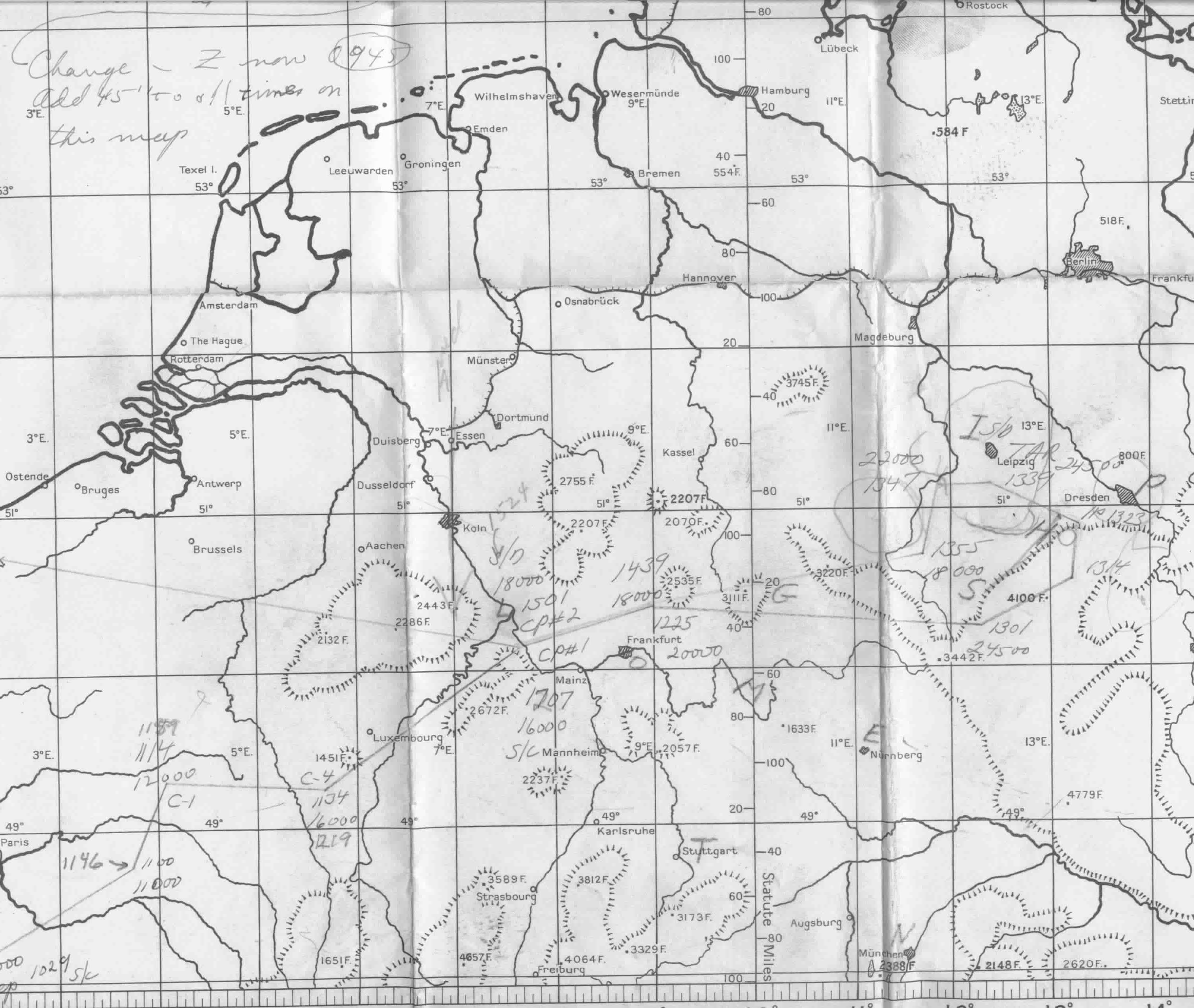
The above map shows the track to the primary target, which is
located
at the 1339 corner near Leipzig. Since the primary target was
overcast,
the decision was made to attack the 3rd target at Plauen, which is near
the "S" on this map. You can see the penciled line just after the
turn marked "IP 1323". The "IP" is where they would normally turn
to start the bomb run, but this time, after turning, they made a second
turn back toward the tertiary target.
The following map obtained at NARA shows the actual track
taken.
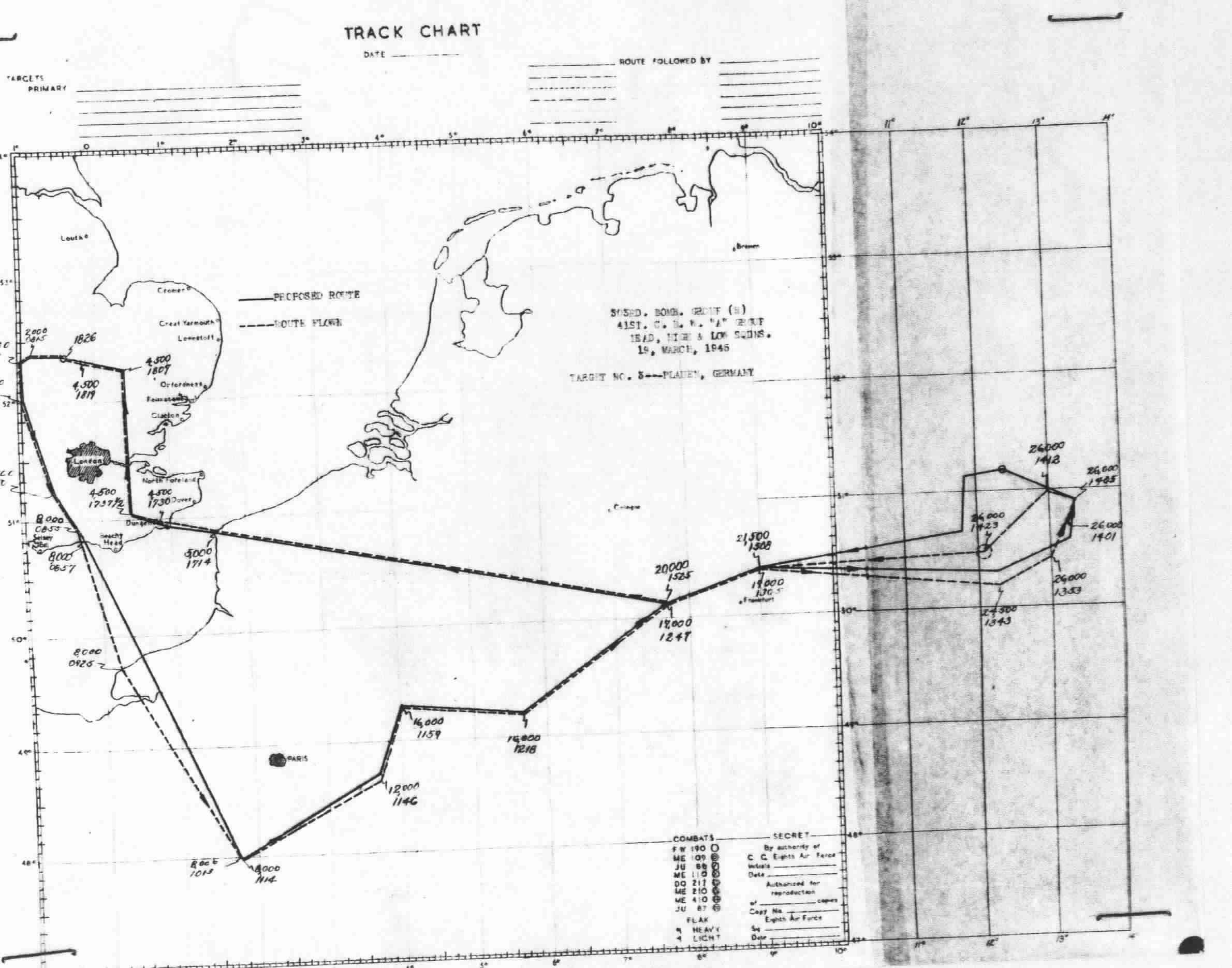
Additional information found at NARA included the original "Field Orders" for the mission. This was too long to copy in it's entirety, however I have included 2 images of parts of the document. The first show the designation of Captain Watson as being the commander for the mission, which is rather unusual, since there were several higher ranking officers flying the mission.
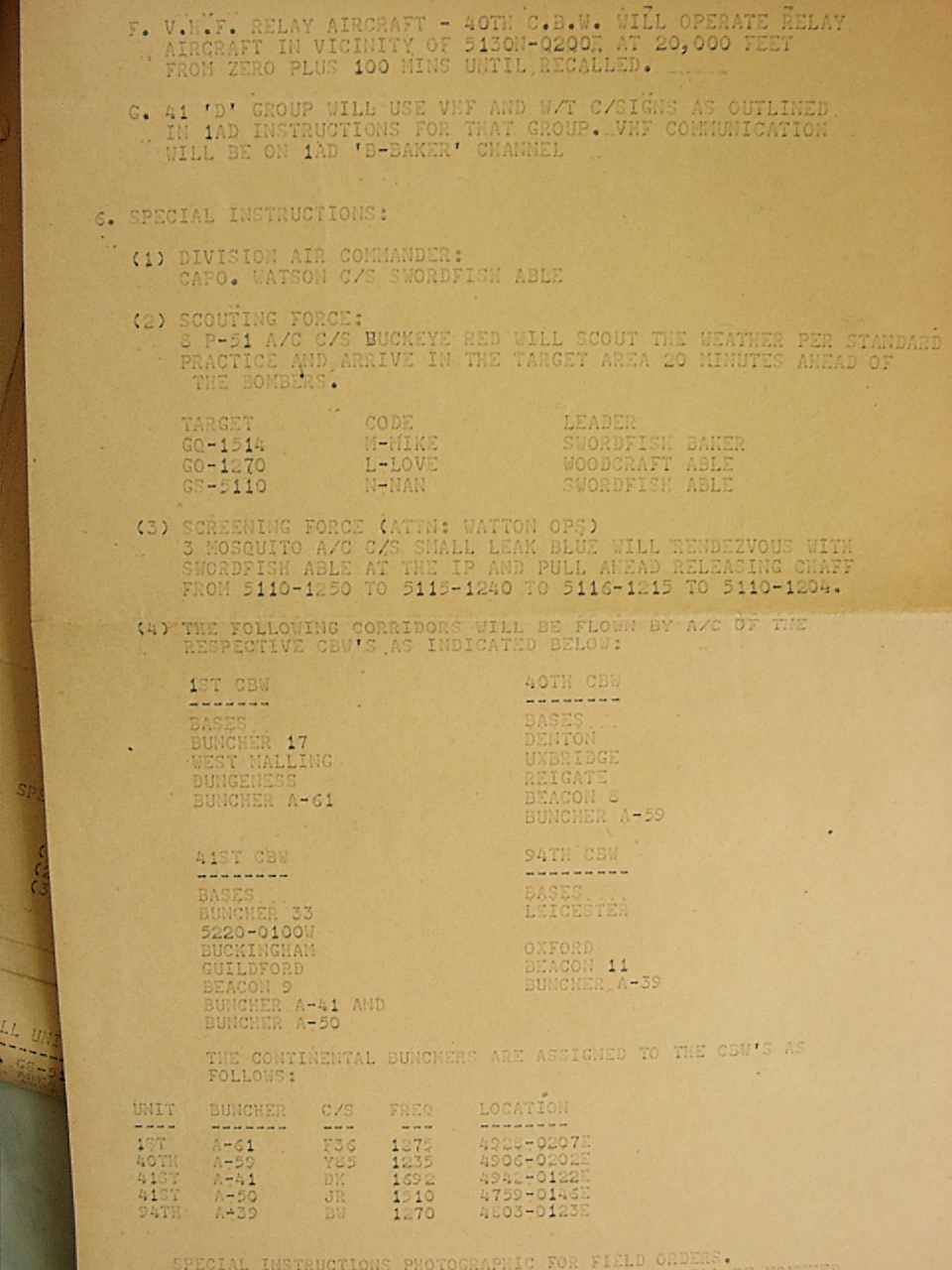
The second image from the field orders includes several things, starting with the list (in order ) of the bomb groups sent out on the mission, starting with the 381stBG, which was lead by Capt Watson. You can't read the Seventh group, but it is the 457thBG. This image also lists each turnpoint, including time and altitude and action.
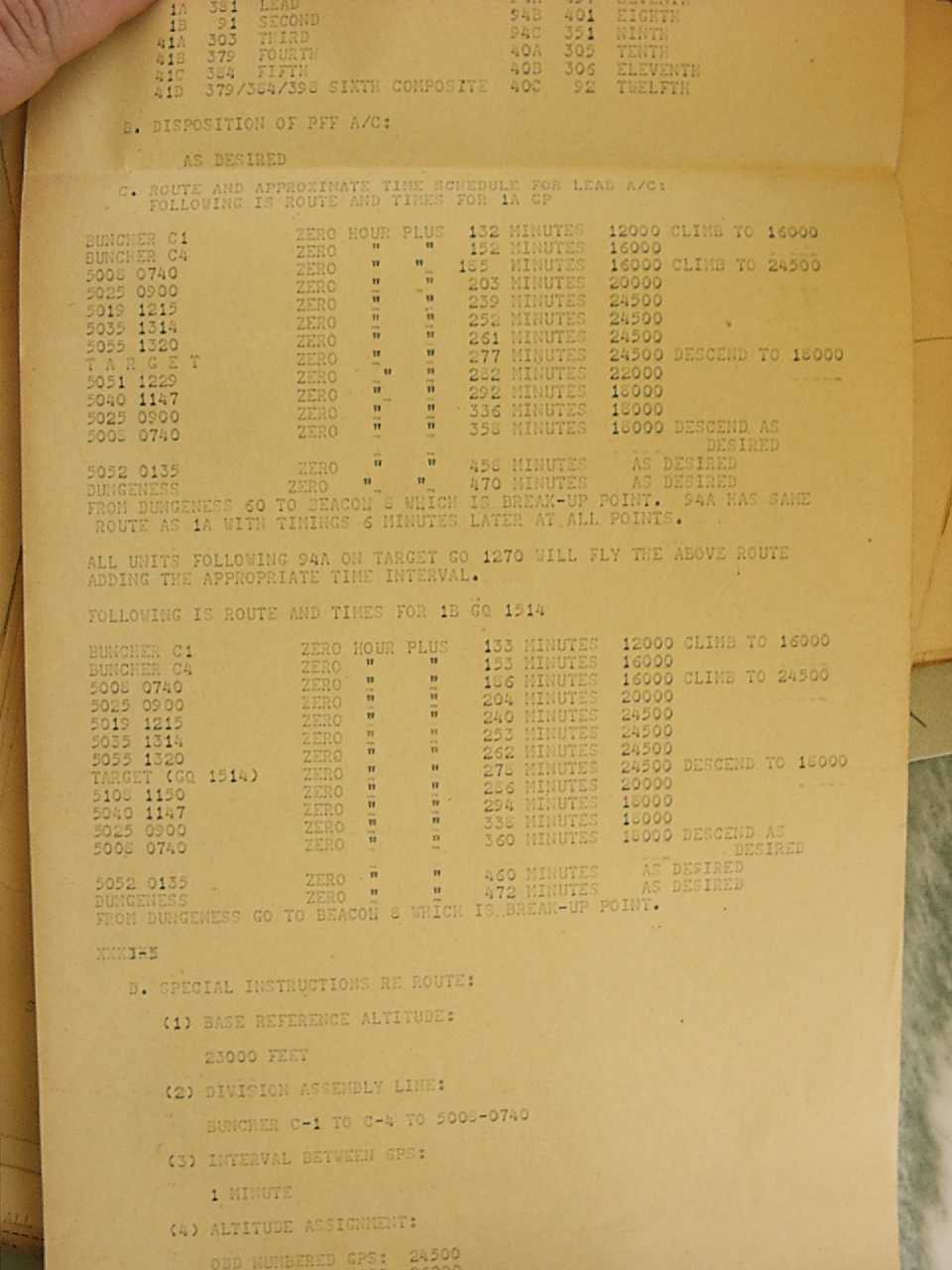
Also of interest with respect to this mission, is the "Pilot's Flimsy", which list callsigns and frequencies for the mission.
